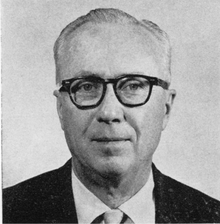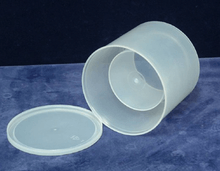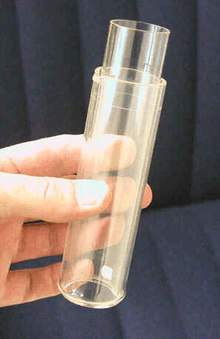Leonidas D. Marinelli
| Leonidas D. Marinelli | |
|---|---|
 Leonidas D. Marinelli | |
| Born |
28 November 1906 Argentina |
| Died |
13 September 1974 (aged 67) Hinsdale, DuPage County, Illinois |
| Fields | Radiologist |
| Institutions |
Memorial Hospital Known today as Memorial Sloan Kettering Cancer Center Argonne National Laboratory |
| Alma mater | Cooper Union |
| Doctoral advisor | Gioacchino Failla |
| Other academic advisors | Gioacchino Failla |
| Known for | Marinelli beaker |
Leonidas D. Marinelli (28 November 1906 – 13 September 1974), was born in Argentina and died in Hinsdale, DuPage County, Illinois was an American radiologist, health physicist and inventor.[1][2]
Life and Education
Marinelli was born of Italian parents in Argentina and in 1906 the family moved back to Italy where rather modest circumstances permitted him only a technical high school education. He immigrated to New York in the late 1920s and supported himself as a meter tester working his way through Cooper Union. His opportunity came with a technician's position in Gioacchino Failla's laboratory at Memorial Hospital (New York City, New York), (known today as Memorial Sloan Kettering Cancer Center), where the groundwork was being done on the quantitative study of X-rays for medical use. By 1933 he was joining Failla, Edith Quimby, and John E. Rose as a coauthor.
Dr. John E. Rose - Health Physicist
Dr. John E. Rose would become Health Physics and radiological physics division director at Argonne. Rose was involved with radiation detection instrumentation, including hand and foot monitors and other detectors. Further note regarding Rose: it was in the Manhattan District of U.S. Army Corps of Engineers that the name "health physics" was born, and great advances were made in radiation safety. From the beginning, the leaders of the Manhattan District recognized that a new and intense source of radiation and radioactivity would be created, and thus, in the summer of 1942, asked Ernest O. Wollan, a cosmic ray physicist at the University of Chicago, to form a group to study and control radiation hazards. Thus, Wollan was the first to bear the title of health physicist. He was soon joined by Carl G. Gamertsfelder, recently graduated physics baccalaureate, and Herbert M. Parker, the noted British-American medical physicist. By mid 1943, six others had been added: Karl Z. Morgan, James C. Hart, Robert R. Coveyou, Ole G. Landsverk, Ph.D. of the Ryerson Physical Laboratory, University of Chicago, L.A. Pardue and Dr. John E. Rose.[3]
Within the Manhattan District, the name health physicist seems to have been derived in part from the need for secrecy (and hence a code name for radiation protection activities) and the fact that there was a group of mostly physicists working on health related problems. Thus, their activities included development of appropriate monitoring instruments, developing physical controls, administrative procedures, monitoring areas and personnel, and radioactive waste disposal—in short, the entire spectrum of modern day radiation protection problems. It was in the Manhattan District that many of the modern concepts of protection were born, including the rem unit, which took into account the biological effectiveness of the radiation, and the maximum permissible concentration (MPC) for inhaled radioactivity. Indeed, it was in the Manhattan District that modern day radiation protection effects, born in the early days of x-ray and radium, realized their maturity.[3]
Career and Profession
In 1935 Marinelli became an Assistant Physicist.
The 1940s saw Marinelli blossoming into an independent scientist. The responsibilities of laboratory director were thrust upon him, by the departure of Failla and Quimby from Memorial, while the explosive growth of radiation medicine gave them further scope.
In 1941 his papers dealt with postirradiation blood studies and with early tracer work on cancer; in 1942 with the production of chromosomal breaks in plant cells and with the theory of time distribution of radiation treatments. Then came the breakthrough of radioiodine therapy, followed by autoradiography techniques and by a Review of Modern Physics report on beta rays. A modicum of economic ease permitted him now to enjoy fully his role of husband and father of a wonderful family.
In 1948 he moved to the Argonne National Laboratory, with a position on the University of Chicago faculty. Here, with John Rose, he provided early leadership and scientific direction of the Radiological Physics Division.
Maturity was marked by authorship of textbook articles on dosimetry in the Annual Review of Nuclear Science, in Radiation Biology, and in the Handbook of Medical Radiology. His studies of physics dealt now with electron diffusion from point sources in air and with the cosmic ray background. In radiology he pioneered the detection of minimal burdens of radioactivity in humans, studying their distribution and variation in tissues and the epidemiology of chronic low levels of radiation. The Center for Human Radiobiology, which now has the responsibility for all AEC-supported research on the effects of internally deposited radioisotopes, grew out of his effort.
Nature granted Marinelli a generous amount of vitality and healthy spirits, but then allowed them to be sapped by early onset of health problems that one would hope to face only later in life. Thus, a shadow of worry and sadness came to surround his later years to the deep sorrow of all those that had been blessed by his warm contact.
Inventions and Patents

Marinelli beaker
The following footnote regarding the Marinelli beaker is found in a report by R.F. Hill, G.J. Hine and L.D. Marinelli (1950) of the Sloan-Kettering Institute in New York:
“This equipment first designed by one of the present authors (L.D.M.) and in use in this laboratory since 1943, can now be obtained from Technical Associates, Inc. Glendale, California.”[4]

Development
In the 1940s and 1950s, the main application of the Marinelli beaker was the analysis of I-131 in liquids (e.g., urine). The original version of the Marinelli beaker, pictured here, consisted of a pyrex/glass laboratory beaker with a central hollow tube projecting from the bottom. A detector, usually a glass GM tube designed for gamma counting, was positioned in the central tube while the beaker was filled with the sample. Since the sample effectively surrounded the detector, the counting efficiency was greater than would be the case if the sample were in any other type of container.[5]
A laboratory often used Marinelli beakers of different sizes - small beakers for small volume samples and large beakers for large volume samples. While it was always possible to increase the volume of a small sample by dilution so that it would fill a large beaker, this sacrificed counting efficiency.[6]
Until the mid-to-late1950’s when liquid scintillation countings came along and gamma scintillators (NaI crystals) became larger and more widely available, the major options for counting liquid samples were Marinelli beakers, jacketed (annular) GM tubes, and dipping GM tubes . Since Marinelli beakers could hold larger volume samples than annular GMs, they had a higher counting efficiency for gamma rays. On the other hand, their efficiency for beta particles was lower than that of annular GM tubes because the betas had to penetrate the glass of the beaker as well as the GM tube wall. Dipping GM tubes, which were dipped into the radioactive solution, were primarily used for beta emitters. While the problem was not as severe as with the annular GM, they could be difficult to clean - a potential problem with long-lived radionuclides.

A different type of alternative was to dry the sample and count it with an end window GM or electroscope (e.g., the Landsverk Model L-75). However, the preparation of dried samples was difficult to perform in a reproducible manner and it risked the volatilization of the iodine.[7]
As NaI detectors became more widely available, workers started to use the type of sample container that most people think of today as the Marinelli beaker: a relatively large plastic jar/beaker with an annular bottom that slid over the NaI crystal (e.g., Haigh, 1954 and Dratz, 1957). Sometimes referred to as a “well-bottom” container, the end of the well was sealed so that the container “hung” from the top of the detector.[8]
Notes
Held a patent for "Apparatus for counting fast neutrons in the presence of gamma rays", US #2795703 A.[9]
Awards and Honors
- Marinelli Road in Rockville, Maryland is named in his honor and the site for the US Nuclear Regulatory Commission headquarters office.
Selected Publications
1930s
- Quimby, E. H., & Marinelli, L. D. (1933). The Influence of Filtration on Surface and Depth Intensities of 200 KV X-rays 1. Radiology, 21(1), 21-29.
- Quimby, E. H., & Marinelli, L. D. (1936). A study of cones or other collimating devices used in roentgen therapy. Radiology, 26(1), 16-26.
- Failla, G., & Marinelli, L. D. (1937). The measurement of the ionization produced in air by gamma rays. Am. J. Roentgenol. Radium Therapy, 38, 312-343.
- Quimby, E. H., Marinelli, L. D., & Farrow, J. H. (1938). A Study of Back-scatter. Am. J. Roentgenol, 39, 799.
- Marinelli, L. D., Blady, J. V., & Quimby, E. (1939). Secondary filters in radium therapy. Amer. J. Roentgenol, 41, 804-816.
1940s
- White, T. N., Marinelli, L. D., & Failla, G. (1940). A measurement of gamma radiation in roentgens. Am. J. Roentgenol, 44, 889-903.
- Kenney, J. M., Marinelli, L. D., & Woodard, H. Q. (1941). Tracer Studies with Radioactive Phosphorus in Malignant Neoplastic Disease 1. Radiology, 37(6), 683-690.
- Marinelli, L. D., & Goldschmidt, B. (1942). The Concentration of P32 in Some Superficial Tissues of Living Patients 1. Radiology, 39(4), 454-463.
- Seidlin, S. M., Marinelli, L. D., & Oshry, E. (1946). Radioactive iodine therapy: effect on functioning metastases of adenocarcinoma of the thyroid. Journal of the American Medical Association, 132(14), 838-847.
- Leiter, L., Seidlin, S. M., Marinelli, L. D., & Baumann, E. J. (1946). Adenocarcinoma of the Thyroid with Hyperthyroidism and Functional Metastases: I. Studies with Thiouracil and Radio-Iodine 123. The Journal of Clinical Endocrinology & Metabolism, 6(3), 247-261.
- Marinelli, L. D., & Foote, F. W. (1947). Retention of radioactive iodine in thyroid carcinomas; histopathologic and radio-autographic studies. The American journal of roentgenology and radium therapy, 58(1), 17.
- Marinelli, L. D., Brinckerhoff, R. F., & Hine, G. J. (1947). Average energy of beta-rays emitted by radioactive isotopes. Reviews of Modern Physics, 19(1), 25.
- Marinelli, L. D., Quimby, E. H., & Hine, G. J. (1948). Dosage determination with radioactive isotopes; practical considerations in therapy and protection. The American journal of roentgenology and radium therapy, 59(2), 260-281.
- Rawson, R. W., Marinelli, L. D., Skanse, B. N., Trunnell, J., & Fluharty, R. G. (1948). The Effect of Total Thyroidectomy on the Function of Metastatic Thyroid Cancer. The Journal of Clinical Endocrinology & Metabolism, 8(10), 826-841.
- Marinelli, L. D. (1949). Dosage determination in the use of radioactive isotopes. Journal of Clinical Investigation, 28(6 Pt 1), 1271.
- Marinelli, L. D., Quimby, E. H., & Hine, G. (1949). [Dosimetry of radioactive isotopes; biological observations and practical applications.]. Strahlentherapie, 81(4), 587-594.
- Rawson, R. W., Skanse, B. N., Marinelli, L. D., & Fluharty, R. G. (1949). Radioactive iodine. Its use in studying certain functions of normal and neoplastic thyroid tissues. Cancer, 2(2), 279-292.
- Trunnell, J. B., Marinelli, L. D., Duffy Jr, B. J., Hill, R., Peacock, W., & Rawson, R. W. (1949). The Treatment of Metastatic Thyroid Cancer with Radioactive Iodine: Credits and Debits. The Journal of Clinical Endocrinology & Metabolism, 9(11), 1138-1152.
1950s
- Hill, R. F., Hine, G. J., and Marinelli, L. D. (1950), The quantitative determination of gamma radiation in biological research. Am. J. Roentgenol. & Radium Therap., 63: 160.
- Marinelli, L. D. (1953). Radiation dosimetry and protection. Annual Review of Nuclear Science, 3(1), 249-270.
- Marinelli, L. D., Norris, W. P., Gustafson, P. F., & Speckman, T. W. (1953). Transport of Radium Sulfate from the Lung and Its Elimination from the Human Body Following Single Accidental Exposures 1. Radiology, 61(6), 903-915.
- Marinelli, L. D., & Taylor, L. S. (1954). The measurement of ionizing radiations for biological purposes. Radiation Biology (A. Hollaender, ed.), 1, 145-190.
- Clark, R. K., Brar, S. S., & Marinelli, L. D. (1955). Ionization of air by beta rays from point sources. Radiology, 64(1), 94.
- Marinelli, L. D., Miller, C. E., Gustafson, P. F., & Rowland, R. E. (1955). The quantitative determination of gamma-ray emitting elements in living persons. Am. J. Roentgenol. Radium Therapy Nuclear Med., 73.
- Hasterlik, R. J., & Marinelli, L. D. (1955, August). Physical dosimetry and clinical observations on four human beings involved in an accidental critical assembly excursion. In Proceedings of the International Conference on the Peaceful Uses of Atomic Energy (Vol. 11, pp. 25–34).
- Marinelli, L. D., Miller, C. E., Rowland, R. E., & Rose, J. E. (1955). Measurement in vivo of radium gamma-ray activities lower than K40 levels existing in the human body. Radiology, 64(1), 116.
- Marinelli, L. D. (1956). The Use of NaI-Tl Crystal Spectrometers in the Study of Gamma-Ray Activity in Vivo: A Summary of Developments at the Argonne National Laboratory. Brit. J. Radiol. Suppl., 7.
- Miller, C. E., & Marinelli, L. D. (1956). Gamma-ray activity of contemporary man. Science, 124(3212), 122-123.
- Miller, C. E., Marinelli, L. D., Rowland, R. E., & Rose, J. E. (1956). Reduction of NaI Background. Nucleonics (US) Ceased publication, 14.
- Miller, C. E., Marinelli, L. D., Rowland, R. E., & Rose, J. E. (1956). An analysis of the background radiation detected by Nal crystals. Nuclear Science, IRE Transactions on, 3(4), 90-96.
- Marinelli, L. D. (1957). U.S. Patent No. 2,795,703. Washington, DC: U.S. Patent and Trademark Office. Marinelli, Leonidas D. "Apparatus for Counting Fast Neutrons." U.S. Patent No. 2,795,703. 11 June 1957.
- Marinelli, L. D. (1958). Radioactivity and the human skeleton. Janeway lecture, 1958. Am. J. Roentgenol. Radium Therapy Nuclear Med., 80.
- Gustafson, P. F., Marinelli, L. D., & Brar, S. S. (1958). Natural and fission-produced gamma-ray emitting radioactivity in soil. Science, 127(3308), 1240-1242.
1960s
- Marinelli, L. D., Miller, C. E., May, H. A., & Rose, J. E. (1961). The use of low level gamma scintillation spectrometry in the measurements of activity in human beings. Radioactivity it, 16-30.
- Marinelli, L. D., Miller, C. E., May, H. A., & Rose, J. E. (1962). Low level gamma-ray scintillation spectrometry: experimental requirements and biomedical applications. Advan. Biol. Med. Phys., 8.
- Marinelli, L. D., Miller, C. E., May, H. A., & Rose, J. E. (1962). Advances in Biological and Medical Physics. CA Tobias and JH Lawrence, Ed, 81-160.
References
- ↑ Fano, U. (1975) Leonidas D. Marinelli (1906–1974). Radiation Research: March 1975, Vol. 61, No. 3, pp. 538-539.
- ↑ Brucer, Marshall. (May 1975) Leonidas D. Marinelli, Ph.D. Radiology, Vol. 115, No. 2:488 –489
- 1 2 Kathren, R. and Ziemer, P., Editors (1980). Health Physics: A Backward Glance. Pergamon Press.
- ↑ Hill, R.F., Hine, G.J. and Marinelli, L.D. (February 1950). "The Quantitative Determination of Gamma Radiation in Biological Research". American Journal of Roentgenology and Radium therapy: 160.
- ↑ Bruner, H.D. and Perkinson, J.D. (October 1952). "A Comparison of Iodine-131 Counting Methods". Nucleonics: 57.
- ↑ Marinelli, L.D. and Hill, R.F. (1948). "Brookhaven National Laboratory Conference Report BNL-C-5": 98.
- ↑ Landsverk, O. G., Wollan, E. O. (29 March 1949). Electrical measuring apparatus. Patent #2,465,886. Washington, D.C.: U.S. Patent and Trademark Office.
- ↑ Dratz, A.F. (August 1957). "Well-Bottom Container Improves Gamma Counting". Nucleonics: 83.
- ↑ Berlman, Isadore B., Marinelli, Leonidas D. (16 March 1954). Apparatus for counting fast neutrons in the presence of gamma rays. Patent #2,795,703A. Washington, D.C.: U.S. Patent and Trademark Office.